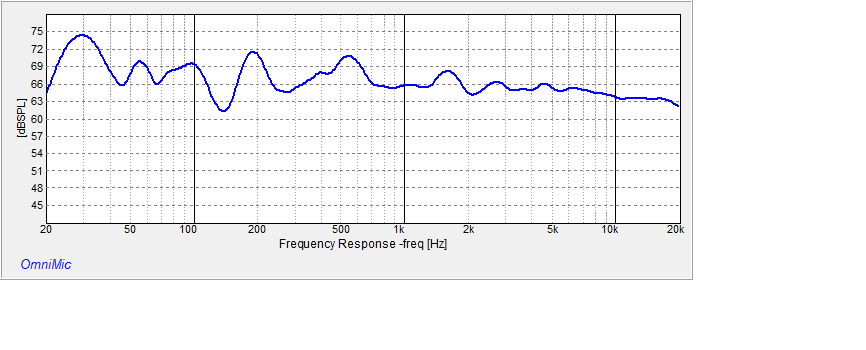what do you account the two large dips at 150 and lesser at 250 Hz in your room? I’m guessing you used a white noise sweep as your source tone?
That and the peak at 30 Hz is all room/speaker/microphone location related. Some of this would probably get smoothed out if I used multiple locations for the mic and averaged them out.
OmniMic uses swept sine waves, not really noise for these measurements.
it is impossible that you are actually getting as much output at 20Hz as you are in the midband.
@herman In an anechoic room you’d be correct. The room however bedevils those expectations, and that’s the point of the posting. Without these measurements I could do sooooo many things wrong in attempting to improve the quality of the bass.
|
At some point over the holidays I'll take measurements at different volumes, I am pretty sure that we won't be able to maintain the bass output, so it will be fun to see how it cuts out as the power goes up.
|
|
@erik_squires , different mike places and volumes would be interesting in themselves, but the averages would be an education. ;)
Have a pleasant Xmas.
|
I guessed the closest. SF Grand Piano uses 6.5" woofs
|
it is impossible that you are actually getting as much output at 20Hz as you are in the midband.
@herman In an anechoic room you’d be correct. The room however bedevils those expectations, and that’s the point of the posting.
I'm going to stick with my initial response. I don't care what kind of room you are in, .. you are not really getting a strong 20 Hz out of those speakers
|
@herman but it is, and I’ve measured it. It’s not "real." It’s not the capability of the speaker so much as the resonance of the room.
Rooms can add 20 dB or more in a node, so this is totally possible. However, it is very much range limited. :)
From my new blog entry, you can see that compression eventually must set in...
Here you can see the output at 60, 70 and 80 dB is fine, only when we get to 90 dB is the output compressed.
|
@herman
I did retest using Room EQ Wizard and OmniMic. REW measures about 5 dB lower at 20 Hz than OmniMIc. It also shows a weird clipping at the top octaves.
While I agree 100% that you can't get loud at 20 Hz with small drivers (this is pure physics) I hope you see that my argument that rooms are complicated and we can't assume we know what's going on without measurement is worthwhile. :)
|
While deep the output is only 75db in the graph so could be anything. Large speakers are needed for full range at high output. Small active speakers go super deep, just not loud without compressing.
|
@james633 - Absolutely right. No way we are getting live level performances out of these.
One thing this shows too though is that if we wanted to use a sub we absolutely have to high pass these speakers or the combination would be a hot mess.
|
Very interesting discussion, Erik thank you for stimulating that.
On the subject of sub woofers, I had my pair turned "off" while the amplifier in one of them was being repaired and I really missed the "visceral" experience they add to the musical experience. When the repaired amp was reinstalled, I used the DSP engine tuning and REW/miniDSP microphone setup to "tune" the subs to the room and the full-range speakers. You've peaked my interest in seeing what REW/miniDSP reports with the sub woofers turned "off".
|
@herman but it is, and I’ve measured it. It’s not "real." It’s not the capability of the speaker so much as the resonance of the room.
I’ll try one more time and then leave you to it. I don’t care how much your room is adding to it, it is impossible you are getting the same level at 20 Hz that you are in the midband with a 6.5 inch speaker.. impossible.... your measurements are incorrect.
something is wrong with your measurements at the top end too when you turn up the midband by 10dB (red to yellow) but at 20KHz it goes up 20dB
if you play a 20 Hz tone do you hear it?
|
@herman
What can I say, I have measured using OmniMic and Room EQ Wizard with two different calibrated mics. The two mics were in agreement except for the range from 20Hz to 30 Hz where UMIK was 3-5 dB down @ 20Hz depending on exactly how I placed the mics. It then merged with the measurements with OmniMic at 30.
I even tried using two different DAC's, one direct and one via Roon. This may not be lab quality work but I'm satisfied it's in the ballpark.
|
|
|
Hi @herman - Yes, I can hear 20 Hz. I have to turn up the volume a bit, I feel it a lot sooner than I hear it. It does not sound like chuffing or distortion.
It's real. It's not as prounounced as 32 Hz, as you'd guess from the graphs but it's really there.
This was played from digitally created test tones.
|


